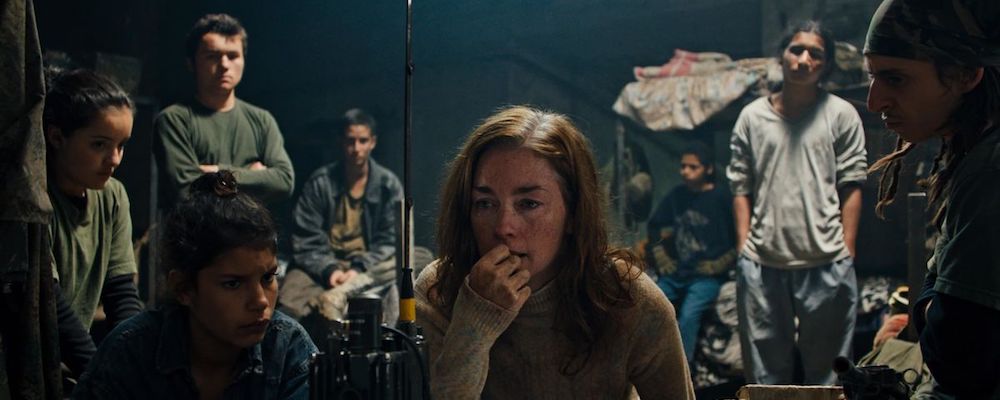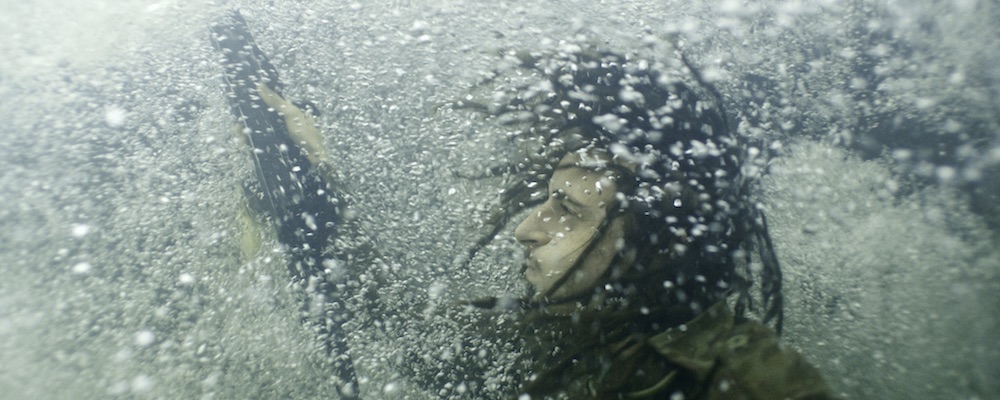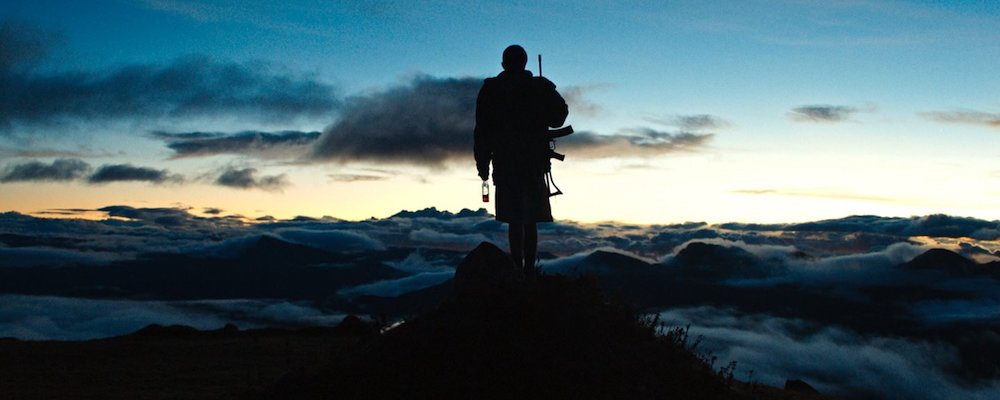Alejandro Landes’ ‘Monos’ Weaves a Poetic Vision of Guerrilla Warfare in an Unknown Land
Alci Rengifo
Director Alejandro Landes‘ “Monos” enters a feverish and hellish setting where guerrillas roam an unnamed Latin American country outside of any specific era. Fueled by Mica Levi‘s otherworldly score, it is one of this year’s most original films, defying genre and many other cinematic conventions. Landes conjures something akin to poetry, using images more than dialogue to convey ideas about war, survival and the human condition. While the characters speak Spanish they could be from any corner of the world in flames.
In a valley of mist and jungle a group of armed rebels have made their base. Known only as “The Organization,” the guerrillas currently hold an American hostage, Doctor Sara Watson (Julianne Nicholson). What exactly their mission is remains unclear, but the group is composed of colorful members such as Patagrande or “Bigfoot” (Moises Arias), Rambo (Sofia Buenaventura), Lobo (Julian Giraldo), Smurf (Deiby RuRueda), Dog (Paul Cubides) and Lady (Karen Quintero). They spend their time under the stern eye of a commander training and quarreling, living under strict rules of conduct. When an ambush scatters the guerrillas they begin to roam the wilderness with Watson as a new struggle for power ensues.
A film like “Monos” contains fierce political and social commentary without adhering to specific doctrines. The Colombian Landes first made his name with a very upfront political documentary, 2007’s “Cocalero,” about the rise of indigenous leftist leader Evo Morales in Bolivia. If that was a work of hope, “Monos” is a darker vision of those who feel they must fight back through taking up arms. The guerrillas never speak about particular political philosophies. No one spouts leftist or right-wing slogans. They exist as irregular fighters in conflict against some kind of distant, phantom enemy regime. The accents and jungle landscapes suggest Colombia during the heated days of the FARC insurrection. Visually Landes via brilliant casting and the evocative cinematography of Jasper Wolf, immerses the viewer in a hallucinatory narrative with shades of “Apocalypse Now” or “Come and See.” The jungle feels unreal in the tone of a dream, the guerrillas will engage in Dionysian partying around a campfire and scenes of combat are hazy (we can’t always tell where the enemy is).
What is truly unique about Landes’s approach is how the guerrillas are well-defined as individuals. Bigfoot is the alpha who feels he knows best when the group is ambushed, assuming leadership where it hasn’t been given to him. His rival in a sense is Lady, who is another strong will in the group. Surrounding them is a brutal terrain where waterfalls are just as dangerous as government troops. Using mostly non-actors from Colombia, which is where shooting took place, Landes captures faces onscreen with a potent authenticity.
Landes, Nicholson and Arias recently sat down with Entertainment Voice to discuss the politics and harsh terrain of “Monos.”
“The idea came from a lot of places,” said Landes, “I wanted to portray adolescence, a moment of great change, of great movement, and juxtapose that with big questions about who you want to be. I think it’s about that time of life where you’re asking yourself what you want to become. That works with a notion of war in a place like my country, Colombia, which had 60 years of civil war. And the nature of that war reminds me of war as we see it today because our grandparents, and great grandparents, fought in those wars that had epic frontlines with flags, uniforms and we knew who was who and where. Today most of the fighting is happening with drones, special operations and covert operations. It’s like a war without frontlines.”
“When I read the script I thought it was amazing, it was basically the movie you saw but on the page.” said Nicholson, “it felt like interesting subjects which I had never seen portrayed in this way…I started asking Alejandro questions, he said ‘I want you to look at it more like a fairy tale.’ He suggested a couple of books to read.” Moore read accounts of FARC kidnap survivors in Colombia and had to take on specific physical habits. “There were practical things like don’t dye your hair, basic grooming went out the window, I just couldn’t do anything I wouldn’t have done there. I had to lose a little bit of weight. I couldn’t eat all the gelato I wanted, which is what I love to do.”
Moises Arias, himself of Colombian descent, came to Landes’s attention through his own work making shorts. “Santiago Zapata, who’s our producer, saw a short film I did with my brother where I speak in Spanish. The script came to me and I’ve never responded quicker. This was a real special project from the jump.” Arias had already been familiar with some of the subject matter. “Having grown up with Colombian parents I had information on this, why they went to New York and why I was born there. It’s common in Colombian culture to just know about this. But the real challenge was being able to speak the language and do what was asked of me. Yes, what’s on paper can be rehearsed, but when you’re working with non-actors there’s a lot that comes out that isn’t on the page. If you want to be the leader and want to scare these kids you need to have the language for it. The guerillas were all non-actors from all over Colombia. I had never lived there. This was the longest time I had spent there.”
What does the title of the film mean? Landes picked it from a specific point of inspiration. “Mono’ in Spanish has a lot of different meanings, it can mean blonde or ‘cute,’ but I took it from its original Greek root which comes from the prefix ‘One,’ as in alone, lonely. So the film narrates the tension between one and the group. That little group is like a mini society.” But even greater significance came with the shoot itself. “It was life-changing, no other word for it,” said Landes, “You don’t really know your limits until you approach them. You naturally shy away from them because of laziness and fear. This film took us all to the limits of what we could do physically and mentally. Sometimes you’re up so high in the mountains there’s not enough oxygen.” Even Landes’s health at one point took quite the turn. “I got carried out on a stretcher by a group of beautiful gold miners who took me up, it was raining like crazy, we couldn’t get chopper down to the set, I needed to be taken out because it looked like my appendix was going to burst, and I got taken out of there. It was a beast.”
Nicholson was left enamored by Colombia and plans to go back. Getting to know her fellow cast, mostly non-English speakers, left its own impression on Nicholson. “They were 15-year-old kids, excited and ready to have fun. But when it was time to work they were very serious. I’ll never forget getting to know them. I don’t speak much Spanish to my own shame. They would laugh all day long and I wish I could know half of what they were saying.”
Arias described traveling to Bogota, Colombia to meet with police officers and train for playing a guerrilla commander. “We went up to a forest that was like a range, and we shot large weapons. It was fun, but the real training came when the next day we had to wake up at 4 A.M. and the rest of the shoot was like that, waking up at 4 in the morning. We also learned the calls of the guerrilla groups. Then we would do a half-hour jog, we learned marching steps. It started with 20 to 30 kids actually in a base camp. Through the base camp and training we managed to find the 8 for the film. From the beginning we knew what were getting into. I wasn’t speaking to my friends because I wanted to stay in character. I think in English and I only wanted to only listen to music in Spanish and only talk with my squad. I didn’t even speak much to Julianne and it worked out because Bigfoot is supposed to treat her poorly.”
Yet for Landes the spirit of the film goes beyond one particular place. These characters and their situation could be happening today in Syria, Yemen or Gaza. “I purposefully gave the film a ghostly feel, breaking with time, not purposefully looking at today’s newspaper but at something bigger.” Landes doesn’t like the label of a “Latin American” director, because he sees cinemas a force that cross over artificial boundaries. But he still has great affection for the region where he was born, grew up and fuels his work. “I love the region, I was born in Brazil, I come from a Colombian family, I grew up a good part of my life in Quito, Ecuador. So I love the region. It speaks to me. Sometimes it’s frustrating. It feels like you’re in love with the wrong girl.”
“Monos” opens Sept. 13 in select theaters.




